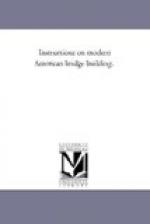Length Safety Length Safety Length Safety given in Weig’t in given in Wt. in given in Wt. in Diameters. Pounds. Diameters. Pounds. Diameters. Pounds.
6 1000 24 440 42 203 8 960 26 394 44 185 10 910 28 358 46 169 12 860 30 328 48 155 14 810 32 299 50 143 16 760 34 276 52 132 18 710 36 258 54 122 20 660 38 239 56 114 22 570 40 224 58 106 60 99
In tensional strains, the length of the beam does not affect the strength; but in the beams submitted to compression, the length is a most important element, and in the table given above, the safety strains to which beams may be subjected, without crushing or bending, has been given for lengths, varying from 6 to 60 diameters.
PRACTICAL RULES.
=Tensional Strain.=
Let T = whole tensional strain. " S = strength per square inch. " a = sectional area in inches. Then we have T = Sa.
Now to find the necessary sectional area for resisting any strain, we have the following general formula:
T
a = —–
S
[TeX: $a = \frac{T}{S}$]
or, by substituting the working strengths for the various materials in the formula, we have for wood,
a = T/2000
Wrought Iron, a = T/1500
Cast Iron, a = T/4500
But, in practice, cast iron is seldom used except to resist compression.
=Strains of Compression.= Allowing the same letters to denote the same things as above, we have for
Wood, a = T/1000
Wrought Iron, a = T/12000
Cast Iron, a = T/25000
As this pamphlet has to do with wooden bridges only, nothing will be said of the proper relative dimensions of cast-iron columns to sustain the strains to which they may be subjected, but a table of the strength of columns will be found further on.
=Transverse Strains.=
Let W = breaking weight in lbs.
" s = constant in table.
" b = breadth in inches.
" d = depth in inches.
" L = length in inches.
Then, for the power of a beam to resist a transverse strain, we shall have,
4 sbd squared W = ------ L
[TeX: $W = \frac{4 sbd^2}{L}$]
This formula has been derived from experiments made by the most reliable authorities.
The constant, 1250, adopted for wood in the following formula, is an average constant, derived from the table, of those woods more commonly used.
Now to reduce the formula to the most convenient shape for use, we substitute the value of s, and we have




